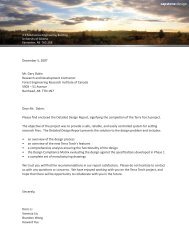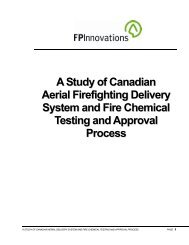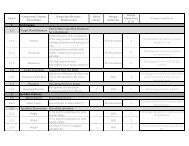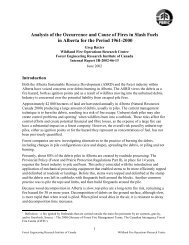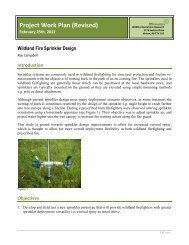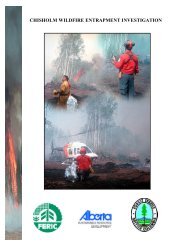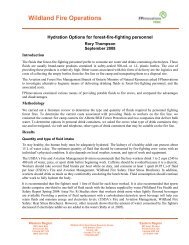An Analysis of Dodge's Escape Fire on the 1949 Mann Gulch Fire in ...
An Analysis of Dodge's Escape Fire on the 1949 Mann Gulch Fire in ...
An Analysis of Dodge's Escape Fire on the 1949 Mann Gulch Fire in ...
You also want an ePaper? Increase the reach of your titles
YUMPU automatically turns print PDFs into web optimized ePapers that Google loves.
<str<strong>on</strong>g>An</str<strong>on</strong>g> <str<strong>on</strong>g>An</str<strong>on</strong>g>alysis <str<strong>on</strong>g>of</str<strong>on</strong>g><br />
Dodge’s s <str<strong>on</strong>g>Escape</str<strong>on</strong>g> <str<strong>on</strong>g>Fire</str<strong>on</strong>g> <strong>on</strong> <strong>the</strong><br />
<strong>1949</strong> <strong>Mann</strong> <strong>Gulch</strong> <str<strong>on</strong>g>Fire</str<strong>on</strong>g><br />
<strong>in</strong> Terms <str<strong>on</strong>g>of</str<strong>on</strong>g> a Survival Z<strong>on</strong>e for<br />
Wildland <str<strong>on</strong>g>Fire</str<strong>on</strong>g>fighters<br />
Marty Alexander<br />
Department <str<strong>on</strong>g>of</str<strong>on</strong>g> Renewable Resources<br />
Mark Ackerman<br />
Department <str<strong>on</strong>g>of</str<strong>on</strong>g> Mechanical Eng<strong>in</strong>eer<strong>in</strong>g<br />
University <str<strong>on</strong>g>of</str<strong>on</strong>g> Alberta, Edm<strong>on</strong>t<strong>on</strong>, Alberta<br />
Greg Baxter<br />
FPInnovati<strong>on</strong>s – Feric Divisi<strong>on</strong>,<br />
Wildland <str<strong>on</strong>g>Fire</str<strong>on</strong>g> Operati<strong>on</strong>s Research Group, H<strong>in</strong>t<strong>on</strong>, Alberta<br />
10th Wildland <str<strong>on</strong>g>Fire</str<strong>on</strong>g> Safety Summit – April 27-30, 2009 – Phoenix, AZ
<strong>Mann</strong> <strong>Gulch</strong> <str<strong>on</strong>g>Fire</str<strong>on</strong>g> Fatalities
<strong>Mann</strong> <strong>Gulch</strong> <str<strong>on</strong>g>Fire</str<strong>on</strong>g> Survivors<br />
Smokejumpers<br />
Bob Sallee and Walt Rumsey<br />
Smokejumper Foreman<br />
Wag Dodge
Smokejumper Pi<strong>on</strong>eer<br />
Earl Cooley publishes<br />
book <strong>in</strong> 1984 and<br />
<strong>in</strong>cludes a chapter <strong>on</strong><br />
<strong>Mann</strong> <strong>Gulch</strong> <str<strong>on</strong>g>Fire</str<strong>on</strong>g><br />
Earl Cooley
Norman Maclean
Dick Ro<strong>the</strong>rmel<br />
<str<strong>on</strong>g>Fire</str<strong>on</strong>g> Management Today summary
The story <str<strong>on</strong>g>of</str<strong>on</strong>g> <strong>the</strong> <strong>Mann</strong><br />
<strong>Gulch</strong> <str<strong>on</strong>g>Fire</str<strong>on</strong>g> has been<br />
chr<strong>on</strong>icled <strong>in</strong> a variety<br />
<str<strong>on</strong>g>of</str<strong>on</strong>g> forms
Websites <strong>on</strong> <strong>Mann</strong> <strong>Gulch</strong> <str<strong>on</strong>g>Fire</str<strong>on</strong>g>
Dodge’s s <str<strong>on</strong>g>Escape</str<strong>on</strong>g> <str<strong>on</strong>g>Fire</str<strong>on</strong>g>: was it a spur <str<strong>on</strong>g>of</str<strong>on</strong>g> <strong>the</strong> moment th<strong>in</strong>g
Questi<strong>on</strong>s to be answered regard<strong>in</strong>g<br />
Dodge’s s escape fire as a survival z<strong>on</strong>e:<br />
How big an area did <strong>the</strong> escape fire burn out<br />
How tall were <strong>the</strong> flames <str<strong>on</strong>g>of</str<strong>on</strong>g> <strong>the</strong> ma<strong>in</strong> advanc<strong>in</strong>g fire fr<strong>on</strong>t<br />
from Useem (1998)
General Approach to <strong>the</strong> Problem<br />
Primary & Sec<strong>on</strong>dary Sources<br />
Photographic evidence<br />
<str<strong>on</strong>g>Fire</str<strong>on</strong>g> Behavior Science<br />
Review and C<strong>on</strong>sultati<strong>on</strong><br />
Dave Turner: Helena NF Historian
Q1: How big an area did <strong>the</strong> escape<br />
fire burn out
The <str<strong>on</strong>g>Fire</str<strong>on</strong>g> Envir<strong>on</strong>ment:<br />
Plentiful supply <str<strong>on</strong>g>of</str<strong>on</strong>g> critically dry,<br />
fully-cured grass fuels <strong>on</strong> a 76% slope
Immediately downw<strong>in</strong>d <str<strong>on</strong>g>of</str<strong>on</strong>g> <strong>the</strong> ma<strong>in</strong> advanc<strong>in</strong>g fire fr<strong>on</strong>t,<br />
<strong>the</strong>re would have been a z<strong>on</strong>e <str<strong>on</strong>g>of</str<strong>on</strong>g> still, smoke-free air <strong>in</strong><br />
which <strong>the</strong> ambient w<strong>in</strong>d would be blocked by <strong>the</strong> fire<br />
and its c<strong>on</strong>vecti<strong>on</strong> column
The “Power <str<strong>on</strong>g>of</str<strong>on</strong>g> <strong>the</strong> Slope”
Walter Rumsey’s s Estimate <str<strong>on</strong>g>of</str<strong>on</strong>g> <str<strong>on</strong>g>Fire</str<strong>on</strong>g> Size<br />
In February 1961 he prepared a<br />
written statement <strong>on</strong> <strong>the</strong> <strong>Mann</strong><br />
<strong>Gulch</strong> <str<strong>on</strong>g>Fire</str<strong>on</strong>g>.<br />
<strong>1949</strong><br />
Rumsey <strong>in</strong>dicated that Dodge lit<br />
his escape fire “with his cigarette<br />
lighter quickly burn<strong>in</strong>g out an<br />
area several hundred feet l<strong>on</strong>g”.<br />
1980<br />
Article entitled “Walter Rumsey’s<br />
Statement Twelve Years After<br />
<strong>Mann</strong> <strong>Gulch</strong>” published<br />
posthumously <strong>in</strong> <strong>the</strong><br />
Smokejumper magaz<strong>in</strong>e <strong>in</strong> 2006.
Starr Jenk<strong>in</strong>s was a Missoula<br />
smokejumper <strong>in</strong> <strong>1949</strong>.<br />
Published book <strong>on</strong> his<br />
experiences <strong>in</strong> 1995, <strong>in</strong>clud<strong>in</strong>g<br />
two chapters related to <strong>the</strong><br />
<strong>Mann</strong> <strong>Gulch</strong> <str<strong>on</strong>g>Fire</str<strong>on</strong>g>.<br />
Indicates that Dodge’s s escape<br />
fire burned “a a half acre <strong>in</strong> 30<br />
sec<strong>on</strong>ds”.<br />
Starr Jenk<strong>in</strong>s<br />
Primary sources were Cooley<br />
(1984) and “recollecti<strong>on</strong>s <str<strong>on</strong>g>of</str<strong>on</strong>g><br />
what survivors Walt Rumsey<br />
and Bob Sallee said around<br />
camp”.
Butler and Cohen (1998):<br />
“Ro<strong>the</strong>rmel (1993)<br />
<strong>in</strong>dicates that <strong>the</strong><br />
escape fire burned<br />
around 90 m [~295 ft]<br />
... Assum<strong>in</strong>g an<br />
elliptical shape ...<br />
with its width<br />
approximately half<br />
<strong>the</strong> length ... <strong>the</strong><br />
escape fire would<br />
have been about 45<br />
m wide [~148 ft].”<br />
This equates to an<br />
area <str<strong>on</strong>g>of</str<strong>on</strong>g> about 0.8<br />
acre.
Ro<strong>the</strong>rmel<br />
(1993) <strong>on</strong><br />
Dodge’s s escape<br />
fire:<br />
“... The ma<strong>in</strong> fire was<br />
<strong>on</strong>ly 50 yds away<br />
when he stopped to<br />
light <strong>the</strong> escape fire.<br />
The ma<strong>in</strong> fire would<br />
cover 50 yds <strong>in</strong> 15 to<br />
30 s if it were<br />
spread<strong>in</strong>g from 360-<br />
610 ft/m<strong>in</strong> ...”
1952 topographic map <str<strong>on</strong>g>of</str<strong>on</strong>g> <strong>the</strong> <strong>Mann</strong> <strong>Gulch</strong> <str<strong>on</strong>g>Fire</str<strong>on</strong>g><br />
*<br />
On a 76%<br />
slope this<br />
equates<br />
to a<br />
horiz<strong>on</strong>tal<br />
or slant<br />
distance<br />
<str<strong>on</strong>g>of</str<strong>on</strong>g> 79 feet.<br />
*Maclean (1992) noted that <strong>the</strong> po<strong>in</strong>ts where “Dodge set<br />
escape fire” and “Dodge survived here” are separated by<br />
three 20-ft c<strong>on</strong>tour <strong>in</strong>tervals (i.e, 60 ft).
Wag Dodge’s s Board <str<strong>on</strong>g>of</str<strong>on</strong>g> Review Testim<strong>on</strong>y<br />
Wag Dodge<br />
“After sett<strong>in</strong>g a clump <str<strong>on</strong>g>of</str<strong>on</strong>g> bunch grass <strong>on</strong> fire, I made an<br />
attempt to start ano<strong>the</strong>r <strong>on</strong>e, but <strong>the</strong> match had g<strong>on</strong>e out<br />
and up<strong>on</strong> look<strong>in</strong>g up, I had an area <str<strong>on</strong>g>of</str<strong>on</strong>g> 100 feet square that<br />
ablaze*. I told <strong>the</strong> man nearest to me that we would wait<br />
a few sec<strong>on</strong>ds to give it a chance to burn out <strong>in</strong>side, and<br />
<strong>the</strong>n we would cross through <strong>the</strong> flames <strong>in</strong>to <strong>the</strong> burned<br />
area ...”.<br />
* Dodge technically meant to say “100 feet squared (i.e., 10 x 10 ft).
Board <str<strong>on</strong>g>of</str<strong>on</strong>g> Review Report:<br />
After light<strong>in</strong>g <strong>the</strong> escape fire<br />
“Dodge <strong>the</strong>n walked around to <strong>the</strong> north [upslope] side <str<strong>on</strong>g>of</str<strong>on</strong>g><br />
<strong>the</strong> fire he had started as an avenue <str<strong>on</strong>g>of</str<strong>on</strong>g> escape. He called<br />
to <strong>the</strong> men to go <strong>in</strong>to <strong>the</strong> burned area, but was<br />
unsuccessful <strong>in</strong> gett<strong>in</strong>g <strong>the</strong>m to do so. He <strong>the</strong>n walked<br />
through <strong>the</strong> flames <strong>in</strong>to <strong>the</strong> burned area for about 30 feet,<br />
lay down, and c<strong>on</strong>t<strong>in</strong>ued to call <strong>the</strong> men to jo<strong>in</strong> him. (The<br />
identical spot Foreman Dodge occupied has been<br />
def<strong>in</strong>itely located and marked. As this time, <strong>the</strong> ma<strong>in</strong> fire<br />
was very close to <strong>the</strong> spot Dodge has fire to provide a<br />
retreat area ...”<br />
Forward spread distance: 79 + 30 = 109 ft
Forward Spread Distance based<br />
Dodge’s s observati<strong>on</strong>s and presumed<br />
elapsed time <str<strong>on</strong>g>of</str<strong>on</strong>g> 30 sec<strong>on</strong>ds<br />
10 ft <strong>in</strong> say 2-32<br />
3 or 2.5 sec<strong>on</strong>ds (estimate <str<strong>on</strong>g>of</str<strong>on</strong>g> time span<br />
between light<strong>in</strong>g <strong>the</strong> first and sec<strong>on</strong>d matches).<br />
Forward Spread Distance = 4 ft/sec x 30 sec = 120 ft<br />
Good agreement with previous estimate <str<strong>on</strong>g>of</str<strong>on</strong>g> 109 ft.<br />
On <strong>the</strong> basis <str<strong>on</strong>g>of</str<strong>on</strong>g> <strong>the</strong>se calculati<strong>on</strong>s, Dodge would have<br />
entered his escape fire with about 3 sec<strong>on</strong>ds left<br />
before <strong>the</strong> area burned by his escape fire was<br />
overrun by <strong>the</strong> ma<strong>in</strong> advanc<strong>in</strong>g fire fr<strong>on</strong>t.<br />
This time could be <str<strong>on</strong>g>of</str<strong>on</strong>g>f by a couple <str<strong>on</strong>g>of</str<strong>on</strong>g> sec<strong>on</strong>ds but<br />
probably not much more.
Length-to<br />
to-Breadth (L/B) Ratio <str<strong>on</strong>g>of</str<strong>on</strong>g> <str<strong>on</strong>g>Escape</str<strong>on</strong>g> <str<strong>on</strong>g>Fire</str<strong>on</strong>g><br />
Based <strong>on</strong> Canadian and Australian<br />
research, a 76% slope is deemed to be<br />
<strong>the</strong> equivalent to a w<strong>in</strong>d speed <str<strong>on</strong>g>of</str<strong>on</strong>g> ~44<br />
mph and a L/B ratio <str<strong>on</strong>g>of</str<strong>on</strong>g> 8:1 <strong>in</strong> grass fuels.
Length-to<br />
to-Breadth (L/B) Ratio vs.<br />
Elapsed Time S<strong>in</strong>ce Igniti<strong>on</strong><br />
L/B = 1.4<br />
@ 30<br />
sec<strong>on</strong>ds<br />
120 ft divided by 1.4 = 86 feet wide at its maximum po<strong>in</strong>t
Estimates <str<strong>on</strong>g>of</str<strong>on</strong>g> Dodge’s s <str<strong>on</strong>g>Escape</str<strong>on</strong>g> <str<strong>on</strong>g>Fire</str<strong>on</strong>g>:<br />
120 ft l<strong>on</strong>g x 86 wide at maximum breadth = 0.2 acre<br />
Assum<strong>in</strong>g a flame fr<strong>on</strong>t residence time (flame<br />
depth/rate <str<strong>on</strong>g>of</str<strong>on</strong>g> fire spread) <str<strong>on</strong>g>of</str<strong>on</strong>g> 5-155<br />
sec<strong>on</strong>ds, <strong>the</strong><br />
so<strong>on</strong>est any burned area would have begun to<br />
appear, would have been after <strong>the</strong> fire had advanced<br />
about 20 ft (i.e., after 5 sec<strong>on</strong>ds or so).
Q2: How tall were <strong>the</strong> flames <str<strong>on</strong>g>of</str<strong>on</strong>g> <strong>the</strong><br />
ma<strong>in</strong> advanc<strong>in</strong>g fire fr<strong>on</strong>t
Calculati<strong>on</strong>s <str<strong>on</strong>g>of</str<strong>on</strong>g> Flame Fr<strong>on</strong>t Dimensi<strong>on</strong>s<br />
Flame fr<strong>on</strong>t residence time: 5-155<br />
sec<strong>on</strong>ds for grass<br />
Rate <str<strong>on</strong>g>of</str<strong>on</strong>g> fire spread: 360 ft/m<strong>in</strong> or 6 ft/sec<br />
Available fuel load: 1.56 t<strong>on</strong>s/acre or 0.072 lb/ft 2<br />
Mid-flame w<strong>in</strong>d speeds: 15-20 mph<br />
Flame depth = 5 sec x 6 ft/sec = 30 ft<br />
to 15 sec x 6 ft/sec = 90 ft<br />
Byram’s s (1959) <str<strong>on</strong>g>Fire</str<strong>on</strong>g>l<strong>in</strong>e Intensity =<br />
Fuel Heat C<strong>on</strong>tent (7444 Btu/lb)<br />
x 0.072 lb/ft2 x 6 ft/sec = 3333 Btu/sec-ft<br />
Equivalent to a Flame Length <str<strong>on</strong>g>of</str<strong>on</strong>g> 19 ft<br />
Nels<strong>on</strong> & Adk<strong>in</strong>s (1986) Flame Height vs. Flame Length<br />
and Mid-flame W<strong>in</strong>d Speed model predicti<strong>on</strong>: 12.5 ft
Maclean (1992):<br />
Flames “would have been thirty feet tall”.<br />
Butler & Cohen (1998):<br />
“Flames were 10 m [33 ft] high (Ro<strong>the</strong>rmel 1993)”.<br />
Ro<strong>the</strong>rmel (1993):<br />
Flames would have “ranged from 10 to 40 ft l<strong>on</strong>g”<br />
Ro<strong>the</strong>rmel & Brown (2000):<br />
“flame lengths might have reached 40 feet”
Flames 30-40 feet tall seems implausible given <strong>the</strong><br />
visual evidence seen <strong>in</strong> <strong>the</strong> immediate post-fire<br />
photography.<br />
Cohen (1983): “Dodge started a fire here that saved<br />
his life. Photo from Jack Nash collecti<strong>on</strong>.”
O<strong>the</strong>r photos from NWCG website c<strong>on</strong>vey same impressi<strong>on</strong>
Wag Dodge, Walter Rumsey & Bob Sallee:<br />
No menti<strong>on</strong> <str<strong>on</strong>g>of</str<strong>on</strong>g> flame heights <str<strong>on</strong>g>of</str<strong>on</strong>g> ma<strong>in</strong> advanc<strong>in</strong>g fire fr<strong>on</strong>t<br />
<strong>in</strong> <strong>the</strong>ir Board <str<strong>on</strong>g>of</str<strong>on</strong>g> Review Testim<strong>on</strong>y or <strong>in</strong> o<strong>the</strong>r documents<br />
Jenk<strong>in</strong>s (1995):<br />
“The wall <str<strong>on</strong>g>of</str<strong>on</strong>g> flame is solid and higher than a man’s s head”<br />
“.... an eight-foot wall <str<strong>on</strong>g>of</str<strong>on</strong>g> flame”
Cheney and Sullivan (2008)<br />
Empirical Relati<strong>on</strong>ship for Predict<strong>in</strong>g Flame Height<br />
from Rate <str<strong>on</strong>g>of</str<strong>on</strong>g> Forward Spread <strong>in</strong> Grasslands<br />
Rate <str<strong>on</strong>g>of</str<strong>on</strong>g> Forward Spread <str<strong>on</strong>g>of</str<strong>on</strong>g> 360 ft/m<strong>in</strong> or 6.5 km/h =<br />
~3 m or 10 ft Flame Height
Butler and Cohen (1998)<br />
4X Flame Height Safety Z<strong>on</strong>e Guidel<strong>in</strong>e
Simulati<strong>on</strong> <str<strong>on</strong>g>of</str<strong>on</strong>g> <strong>the</strong> <strong>the</strong>rmal envir<strong>on</strong>ment <strong>in</strong><br />
Dodge’s s escape fire<br />
Path <str<strong>on</strong>g>of</str<strong>on</strong>g> Flame Center<br />
Elliptical Clear<strong>in</strong>g<br />
Xc,Yc<br />
• Ly<strong>in</strong>g pr<strong>on</strong>e <strong>on</strong> <strong>the</strong><br />
ground<br />
• Flame depth – 30 ft<br />
• Flame height – 10 ft<br />
Planar Flame Fr<strong>on</strong>t<br />
Xf,Yf<br />
Flame Width 300 ft<br />
Flame <str<strong>on</strong>g>An</str<strong>on</strong>g>gle<br />
• Flame fr<strong>on</strong>t<br />
residence time –<br />
10 sec<br />
Flame Depth 30 ft
Critical Radiant Heat Flux for a<br />
Flame Fr<strong>on</strong>t Residence Time <str<strong>on</strong>g>of</str<strong>on</strong>g> 10 sec<strong>on</strong>ds<br />
is 30 kW/m 2 for a clo<strong>the</strong>d firefighter<br />
90<br />
Time to 2 nd Degree Burn, sec<strong>on</strong>ds<br />
80<br />
70<br />
60<br />
50<br />
40<br />
30<br />
20<br />
10<br />
T = 466.7Q -1.1374<br />
Proban<br />
Endura<br />
Nomex III<br />
PK<br />
0<br />
0 5 10 15 20 25 30<br />
Heat Flux (kW/m 2 )
Maximum Heat Flux Dur<strong>in</strong>g Flame Fr<strong>on</strong>t Passage<br />
kW/m 2
Maximum Heat Flux Dur<strong>in</strong>g Flame Fr<strong>on</strong>t Passage<br />
kW/m 2
Maximum Heat Flux Dur<strong>in</strong>g Flame Fr<strong>on</strong>t Passage<br />
kW/m 2
Maximum Heat Flux Dur<strong>in</strong>g Flame Fr<strong>on</strong>t Passage<br />
kW/m 2
EPILOGUE:<br />
Did Dodge really get lifted <str<strong>on</strong>g>of</str<strong>on</strong>g>f <strong>the</strong> ground<br />
“Dodge later told Earl Cooley that, when <strong>the</strong> fire went over<br />
him, he was lifted <str<strong>on</strong>g>of</str<strong>on</strong>g>f <strong>the</strong> ground two or three times”<br />
(Maclean 1992).<br />
“Dodge said fierce w<strong>in</strong>ds lifted him <str<strong>on</strong>g>of</str<strong>on</strong>g>f <strong>the</strong> ground three<br />
times dur<strong>in</strong>g <strong>the</strong> few m<strong>in</strong>utes it took <strong>the</strong> fire to pass over<br />
him ...” (Ro<strong>the</strong>rmel 1993).<br />
“Wag suddenly felt buoyant, as if he were <strong>in</strong> a big vacuum,<br />
and <strong>the</strong> extreme gusts <str<strong>on</strong>g>of</str<strong>on</strong>g> hot air lifted him from <strong>the</strong> ground<br />
three separate times” (Mat<strong>the</strong>ws 2007).
The Counter View<br />
“There were extreme gusts <str<strong>on</strong>g>of</str<strong>on</strong>g> hot air that almost<br />
lifted me from <strong>the</strong> ground as <strong>the</strong> fire passed over me”<br />
– Wag Dodge (statement <strong>in</strong> Cooley 1984).<br />
“Three violent gusts <str<strong>on</strong>g>of</str<strong>on</strong>g> superheated air nearly lifted<br />
him from <strong>the</strong> ground” – The Missoulian newspaper,<br />
14 August <strong>1949</strong> (cited <strong>in</strong> Lillquist 2006).<br />
It’s s estimated that w<strong>in</strong>ds >87 mph would have been<br />
required to physically lift Dodge <str<strong>on</strong>g>of</str<strong>on</strong>g>f <strong>the</strong> ground.<br />
While this is certa<strong>in</strong>ly with<strong>in</strong> <strong>the</strong> range <str<strong>on</strong>g>of</str<strong>on</strong>g> entra<strong>in</strong>ment<br />
w<strong>in</strong>ds observed <strong>on</strong> fires <strong>in</strong>volv<strong>in</strong>g large quantities <str<strong>on</strong>g>of</str<strong>on</strong>g><br />
fuel, such w<strong>in</strong>ds have not been measured <strong>on</strong> grass<br />
fires.
In Summary<br />
It’s s estimated that <strong>the</strong> Dodge’s s escape fire burned<br />
out an area <str<strong>on</strong>g>of</str<strong>on</strong>g> about 0.2 acre <strong>in</strong> size (i.e., ~120 feet <strong>in</strong><br />
length and 86 feet <strong>in</strong> breadth) before be<strong>in</strong>g overrun.<br />
It’s s estimated that <strong>the</strong> flames <str<strong>on</strong>g>of</str<strong>on</strong>g> <strong>the</strong> ma<strong>in</strong> advanc<strong>in</strong>g<br />
fire fr<strong>on</strong>t were around 10 feet high or tall when <strong>the</strong>y<br />
met <strong>the</strong> escape fire.<br />
It’s s c<strong>on</strong>cluded that Dodge’s s escape fire was large<br />
enough to safely accommodate all 16 firefighters (i.e.,<br />
<strong>the</strong> 15 smokejumpers and <strong>on</strong>e fire guard) ly<strong>in</strong>g down.<br />
It seems highly unlikely that Dodge was physically<br />
lifted <str<strong>on</strong>g>of</str<strong>on</strong>g>f <strong>the</strong> ground as <strong>the</strong> ma<strong>in</strong> fire passed around<br />
his escape fire.



